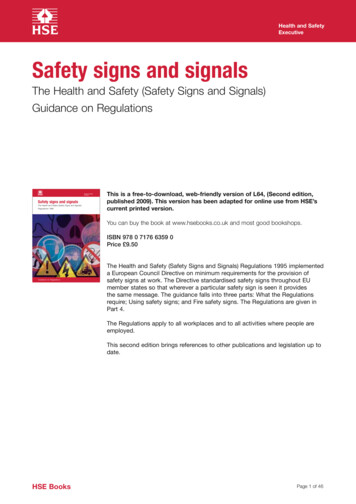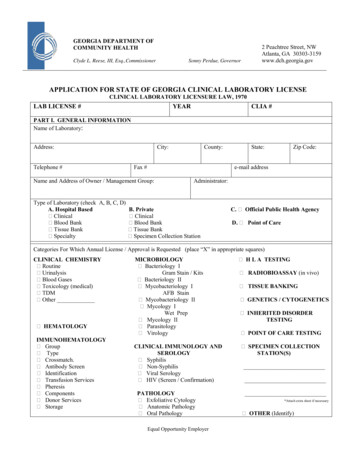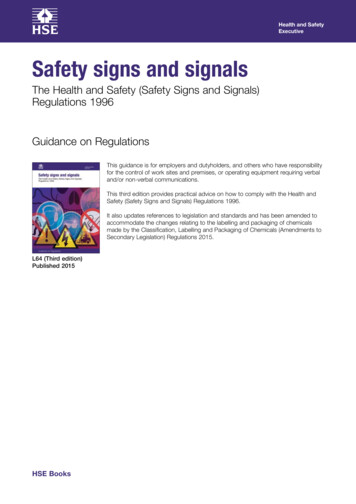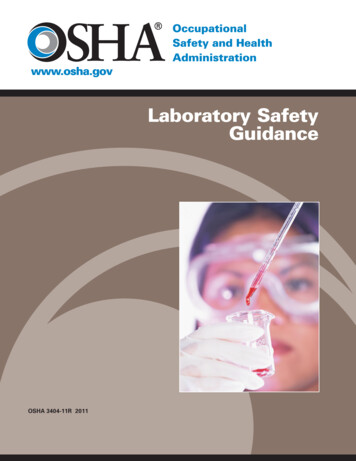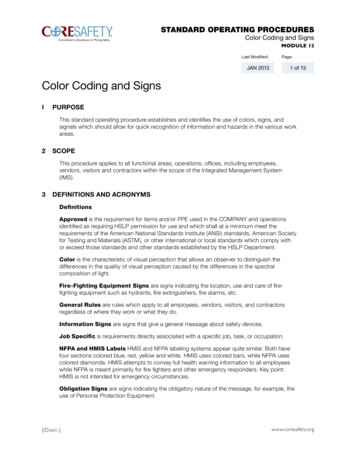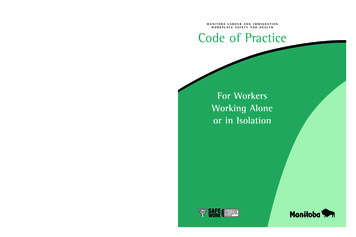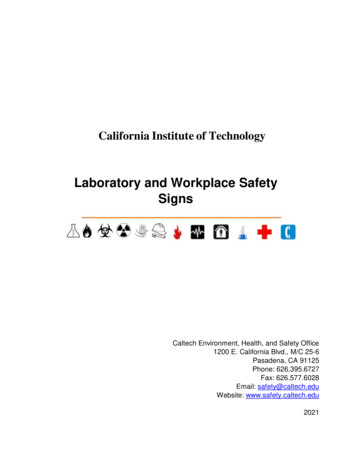
Transcription
California Institute of TechnologyLaboratory and Workplace SafetySignsCaltech Environment, Health, and Safety Office1200 E. California Blvd., M/C 25-6Pasadena, CA 91125Phone: 626.395.6727Fax: 626.577.6028Email: safety@caltech.eduWebsite: www.safety.caltech.edu2021
Table of ContentsScope . 3Purpose . 3Responsibilities . 3PI's, Managers, Supervisors, Safety Officer, and/or Responsible Person . 3Environment, Health, and Safety . 3Classification of Signs and Requirements . 4General Safety Signs . 4Danger Signs. 4Warning Signs . 4Caution Signs . 5Biological Hazard Signs . 5Radiation Warning Signs . 6Laser Hazard Signs . 6Proposition 65 Signs. 6Locations . 7Caltech’s Laboratory Emergency Information Signs . 7Determining Rating Number for NFPA Sign . 8Health Hazard . 8Flammability Hazard . 8Reactivity Hazard . 8Special Hazards . 8Locations . 8Filling Out the NFPA Sign . 8Posting the Sign. 9Appendix 1: Factors Used to Determine NFPA Ratings of Chemicals . 10Table 1: Degrees of Health Hazards . 10Table 2: Degrees of Flammability Hazards. 12Table 3: Degrees of Instability Hazards. 14Laboratory and Workplace Safety Signs2
Laboratory and Workplace Safety SignsScopeThis program applies to the design, application, and use of signs or symbols at The CaliforniaInstitute of Technology (Caltech) to define specific hazards of a nature such that failure todesignate them may lead to accidental injury to students, employees, contractors and the public,or cause property damage.PurposeThe purpose of this program is to provide guidance in regards to the accident prevention signsused at Caltech and to ensure that the various meanings of accident prevention signs and thehazards that they represent are conveyed effectively.This program is also in place to comply with the following regulations and standards relating toaccident prevention signs: Title 8, California Code of Regulations (CCR), Section 3340 – Accident Prevention SignsCalifornia Health and Safety Code, Section 25249.6 – Clear and Reasonable Warning,Proposition 65 Sign, Office of Environmental Health Hazard Assessment (OEHHA)National Fire Protection Association (NFPA) 704, Standard System for the Identification ofthe Hazards of Materials for Emergency Response (Fire Diamond)Title 10, Code of Federal Regulations (CFR), Section 20.1902 – Posting RequirementsResponsibilitiesPI’s, Managers, Supervisors, Safety Officer, and/or Responsible Person Ensure that accident prevention warning signs in respective areas are up to date, visible,and in good condition.Ensure that students and employees recognize and understand the meaning of accidentprevention signs.Environment, Health, and Safety Provide guidance on the completion and placement of required accident prevention signs.Laboratory and Workplace Safety Signs3
Classification of Signs and RequirementsGeneral Safety SignsGeneral safety signs are found throughout campus and shall be used where there is a need forgeneral instructions and suggestions relative to safety measures that requires signage.Danger SignsDanger signs shall be used only where an immediatehazard exists. All employees are instructed that dangersigns indicate immediate danger and that specialprecautions are necessary. Danger signs consist of thecolors red, black, and white only.Danger signs can be found in laboratories, trade shops, chemical storage areas, central plant andother areas where an immediate hazard may exist that requires signage. Examples of wording are: DANGER – FLAMMABLE MATERIAL, No SmokingDANGER – CORROSIVE LIQUIDS, Wear Protective EquipmentDANGER – LASER RADIATION, avoid eye or skin exposure to direct or scatter radiationWarning SignsWarning signs shall be used to indicate a potentiallyhazardous situation which, if not avoided, could resultin death or serious injury. All employees are instructedthat warning signs indicate a potentially hazardoussituation that could result in death or serious injury.Warning signs shall be used to indicate a potentially hazardous situation which, if not avoided,could result in death or serious injury. Examples of wording for “WARNING” signs are: WARNING – PINCH POINTWARNING – This Machine Starts AutomaticallyLaboratory and Workplace Safety Signs4
Caution SignsCaution signs shall be used only to warn against potentialhazards or to caution against unsafe practices. Allemployees are instructed that caution signs indicate apossible hazard against which proper precaution shouldbe taken. Standard color of the background is yellow;and the panel, black with yellow letters. Any letters usedagainst the yellow background will be black.Caution signs can be found throughout campus to warn against potential hazards or to cautionagainst unsafe practices. Examples of wording for “CAUTION” signs include: CAUTION – NO CHEMICALS IN DRAINS, Use Chemical Waste ContainersCAUTION – WATCH YOUR STEPCAUTION – Potential hazard in laboratoryBiological Hazard SignsBiohazard warning signs are posted in areas and laboratoriesthat contain biohazardous agents or potentially infectiousmaterials.The biological hazard warning sign is used to signify the actual or potential presence of abiohazard, or potentially infectious material and to identify equipment, containers, rooms,material, experimental animals, or combinations thereof, which contain, or are contaminatedwith, viable hazardous agents. The biohazard symbol design is fluorescent orange or orange-redcolor. Background color is optional as long as there is sufficient contrast for the symbol to beclearly defined. Appropriate wording may be used in association with the symbol to indicate thenature or identity of the hazard, name of individual responsible for its control, precautionaryinformation, etc., but this information must not be superimposed on the symbol.Laboratory and Workplace Safety Signs5
Radiation Warning SignsRadiation warning signs indicate the types of exposurelevels that may be present in the lab or area. Magenta orblack on a yellow background are the internationallyrecognized colors used to signify the presence of ionizingradiation. The symbol used is called the trefoil.Depending on the level of radiation present, the following signage may be used: Caution – X-ray. This warning sign is used to indicate use of radiation producing machine inthat location.Caution – Radioactive Materials. This warning sign is used to indicate that radioactivematerials are used or stored in this lab or area.Caution – Radiation Area. This warning sign is used to indicate areas where radiationlevels may exist that are in excess of 5 millirem (mrem) per hour at a distance of 30centimeters (cm) from the source of radiation or from any surface that the radiationpenetrates.Caution – High Radiation Area. This warning sign is used to indicate areas where radiationlevels may exist that are in excess of 100 mrem per hour at a distance of 30 cm from thesource of radiation or from any surface that the radiation penetrates.Radiation Warning Labels. Use radiation warning labels to mark containers andequipment used to manipulate or store radioactive materials, contaminated items, orother sources of ionizing radiation.Laser Hazard SignsLaser hazard warning signs are used to indicate theactual or potential laser light hazard in thelaboratory or in an area.Danger laser radiation sign is used for class 3b and 4 lasers.Proposition 65 SignsProposition 65 (Prop 65) is a California regulation that requires businesses to notify students,employees, visitors, contractors, etc. about detectable amounts of certain chemicals in theproducts they purchase, in their homes or workplaces, or that are released into the environment.Businesses are required to provide a "clear and reasonable" warning before knowingly andLaboratory and Workplace Safety Signs6
intentionally exposing anyone to a chemical listed on the Proposition 65 list. Caltech posts Prop65 warning signs throughout the workplace. The sign must clearly communicate that the chemicalin question is known to the state to cause cancer, or birth defects or other reproductive harm.LocationsProposition 65 signs should be posted at the entrances to buildings or areas where listedchemicals may be present.At Caltech, Proposition 65 is present at the bottom of each of the Accident Prevention WarningSigns denoted by the following:WARNING – THIS AREA CONTAINS A CHEMCIAL KNOWN TO THE STATE OF CALIFORNIA TO CAUSECANCER OR BIRTH DEFECTS OR OTHER REPRODUCTIVE HARMNational Fire Protection Association (NFPA) 704, Standard System for theIdentification of the Hazards of Materials for Emergency Response (Fire Diamond)NFPA 704 is part of the Accident PreventionWarning Signs that are placed on the door orwall prior to entering an area where thehazards may be present. They are intended toprovide emergency responders with theinformation they need to determine theimmediate actions to be taken in anemergency.NFPA 704 provides criteria for assessing the health, flammability, reactivity, and related hazardsthat are presented by short-term, acute exposure to a material under conditions of fire, spill, orsimilar emergencies. A number rating system of 0-4 (zero being the least hazardous and four beingthe most hazardous) is provided to rate health, flammability, and reactivity and symbols (i.e. W,Ox, SA) are located in the white area for special hazards. The NFPA system uses a “diamondshape” to succinctly display the type of hazards present. See Appendix 1 for information on howchemical manufactures determine the ratings.Caltech’s Laboratory Emergency Information SignsThe following guidance should be used for the evaluation of the chemical hazard and completionof the NFPA diamond. You can find blank copies of the standard NFPA Laboratory Safety on theEnvironment, Health, and Safety website.Laboratory and Workplace Safety Signs7
Determining Rating Number for NFPA SignUse the criteria below to determine the number rating required to be posted in each of thesections of the NFPA diamond.To find the NFPA classification rating for a chemical, refer to the Safety Data Sheet (SDS), chemicallabel, or contact the EH&S Office for assistance. The following should be used for the evaluation ofthe hazard rating for a given area:Health HazardFlammability HazardReactivity HazardSpecial HazardsPost the highest NFPA classification ratingpresent in the area regardless of amountNFPA 4- More than 5 gallons (NFPA, Class IA)and/or any flammable gases.NFPA 3- 5 gallons or less (NFPA, Class IA)and/or 10 gallons or less of (Class 1B, 1C)).NFPA 2- 2 gallons or less (NFPA, Class IA)and/or 4 gallons or less of (Class 1B, 1C).NFPA 1- Less than 1 gallon (NFPA 4, Class IA)and/or 2 gallons or less of (Class 1B, 1C).Post the highest NFPA classification ratingpresent in the area regardless of amountPost the appropriate special hazard regardlessof amountLocationsEmergency Information Signs are required to be posted at the entrance to each lab wherehazardous material is stored or where potential hazards exist.Filling out the NFPA Sign Enter full building name and room/laboratory number on the sign. Enter the emergency contact information. The recommended emergency contacts forlaboratories are the Principal Investigator and group Safety Officer. Select one of the following signs based on the materials present in your laboratory.o For chemicals useo For chemical hazards that require a rating of 4 in any of the categories on the NFPA“diamond” or that have special hazards useo For Biohazards and radioactive material useo For Biohazards useo For Radioactive material useMark the appropriate checks for personal protective equipment required in the area. Laboratory and Workplace Safety Signs8
Mark the appropriate checks for the hazards present in the laboratory. Note: when “other”is checked, indicate specifics in the "list specifics" column such as:o Water Reactive Materialo Neurotoxinso Biohazards (Indicate Biohazard classification, i.e. Minimal Hazard) o Health, Flammability and/or Reactivity hazards rated 3 or above.Enter the date the sign was updated on.Posting the SignAfter completing all information on the sign: Install the sign on the wall by the entrance to the room or laboratory. The sign should hangat eye level. DO NOT INSTALL ON THE DOOR.Laboratory and Workplace Safety Signs9
Appendix 1: Factors Used to Determine NFPA Ratings of ChemicalsTable 1: Degrees of Health HazardsDegree of Hazard*4 — Materials that, underemergency conditions, can belethal.Criteria 3 — Materials that, underemergency conditions, cancause serious or permanentinjury. Gases whose LC50 for acute inhalation toxicity is less than or equalto 1000 parts per million (ppm).Any liquid whose saturated vapor concentration at 20 C (68 F) isequal to or greater than ten times its LC50 for acute inhalationtoxicity, if its LC50 is less than or equal to 1000 ppm.Dusts and mists whose LC50 for acute inhalation toxicity is less thanor equal to 0.5 milligrams per liter (mg/L).Materials whose LD50 for acute dermal toxicity is less than or equalto 40 milligrams per kilogram (mg/kg).Materials whose LD50 for acute oral toxicity is less than or equal to5 mg/kg.Gases whose LC50 for acute inhalation toxicity is greater than 1000ppm but less than or equal to 3000 ppm.Any liquid whose saturated vapor concentration at 20 C (68 F) isequal to or greater than its LC50 for acute inhalation toxicity, if itsLC50 is less than or equal to 3000 ppm and that does not meet thecriteria for degree of hazard 4.Dusts and mists whose LC50 for acute inhalation toxicity is greaterthan 0.5 mg/L but less than or equal to 2 mg/L.Materials whose LD50 for acute dermal toxicity, is greater than 40mg/kg but less than or equal to 200 mg/kg.Materials that are corrosive to the respiratory tract.Materials that are corrosive to the eye or cause irreversible cornealopacity.Materials that are corrosive to skin.Cryogenic gases that cause frostbite and irreversible tissuedamage.Compressed liquefied gases with boiling points at or below -55 C (66.5 F) that cause frostbite and irreversible tissue damage.Materials whose LD50 for acute oral toxicity, is greater than 5mg/kg but less than or equal to 50 mg/kg.Laboratory and Workplace Safety Signs10
Degree of Hazard*2 — Materials that, underemergency conditions, cancause temporaryincapacitation or residualinjury.Criteria 1 — Materials that, underemergency conditions, cancause significant irritation. 0 — Materials that, underemergency conditions, wouldoffer no hazard beyond thatof ordinary combustiblematerials. Gases whose LC50 for acute inhalation toxicity is greater than 3000ppm but less than or equal to 5000 ppmAny liquid whose saturated vapor concentration at 20 C (68 F) isequal to or greater than one-fifth its LC50 for acute inhalationtoxicity, if its LC50 is less than or equal to 5000 ppm and that doesnot meet the criteria for either degree of hazard 3 or degree ofhazard 4.Dusts and mists whose LC50 for acute inhalation toxicity is greaterthan 2 mg/L but less than or equal to 10 mg/L.Materials whose LD50 for acute dermal toxicity, is greater than 200mg/kg but less than or equal to 1000 mg/kg.Compressed liquefied gases with boiling points between -30 C (22 F) and -55 C (-66.5 F) that can cause severe tissue damage,depending on duration of exposure.Materials that are respiratory irritants.Materials that cause severe but reversible irritation to the eyes orlacrimators.Materials that are primary skin irritants or sensitizers.Materials whose LD50 for acute oral toxicity, is greater than 50mg/kg but less than or equal to 500 mg/kg.Gases and vapors whose LC50 for acute inhalation toxicity is greaterthan 5000 ppm but less than or equal to 10,000 ppm.Dusts and mists whose LC50 for acute inhalation toxicity is greaterthan 10 mg/L but less than or equal to 200 mg/L.Materials whose LD50 for acute dermal toxicity is greater than 1000mg/kg but less than or equal to 2000 mg/kg.Materials that cause slight to moderate irritation to the respiratorytract, eyes, and skin.Materials whose LD50 for acute oral toxicity is greater than 500mg/kg but less than or equal to 2000 mg/kg.Gases and vapors whose LC50 for acute inhalation toxicity is greaterthan 10,000 ppm.Dusts and mists whose LC50 for acute inhalation toxicity is greaterthan 200 mg/L.Materials whose LD50 for acute dermal toxicity is greater than 2000mg/kg.Materials whose LD50 for acute oral toxicity is greater than 2000mg/kg.Materials that are essentially nonirritating to the respiratory tract,eyes, and skin.*For each degree of hazard, the criteria are listed in a priority order based upon the likelihood ofLaboratory and Workplace Safety Signs11
Degree of Hazard*Criteriaexposure.Table 2: Degrees of Flammability HazardsDegree of HazardCriteria4 — Materials that will rapidlyor completely vaporize atatmospheric pressure andnormal ambient temperatureor that are readily dispersedin air and will burn readily. 3 — Liquids and solids thatcan be ignited under almostall ambient temperatureconditions. Materials in thisdegree produce hazardousatmospheres with air underalmost all ambienttemperatures or, thoughunaffected by ambienttemperatures, are readilyignited under almost allconditions. 2 — Materials that must bemoderately heated orexposed to relatively highambient temperatures beforeignition can occur. Materialsin this degree would notunder normal conditions formhazardous atmospheres withair, but under high ambienttemperatures or undermoderate heating couldrelease vapor in sufficient Flammable gases.Flammable cryogenic materials.Any liquid or gaseous material that is liquid while under pressureand has a flash point below 22.8 C (73 F) and a boiling point below37.8 C (100 F) (i.e., Class IA liquids).Materials that ignite spontaneously when exposed to air.Solids containing greater than 0.5 percent by weight of aflammable or combustible solvent are rated by the closed cup flashpoint of the solvent.Liquids having a flash point below 22.8 C (73 F) and having aboiling point at or above 37.8 C (100 F) and those liquids having aflash point at or above 22.8 C (73 F) and below 37.8 C (100 F) (i.e.,Class IB and Class IC liquids).Materials that on account of their physical form or environmentalconditions can form explosive mixtures with air and that are readilydispersed in air.Flammable or combustible dusts with representative diameter lessthan 420 microns (40 mesh).Materials that burn with extreme rapidity, usually by reason ofself-contained oxygen (e.g., dry nitrocellulose and many organicperoxides).Solids containing greater than 0.5 percent by weight of aflammable or combustible solvent are rated by the closed cup flashpoint of the solvent.Liquids having a flash point at or above 37.8 C (100 F) and below93.4 C (200 F) (i.e., Class II and Class IIIA liquids).Solid materials in the form of powders or coarse dusts ofrepresentative diameter between 420 microns (40 mesh) and 2mm (10 mesh) that burn rapidly but that generally do not formexplosive mixtures with air.Solid materials in a fibrous or shredded form that burn rapidly andcreate flash fire hazards, such as cotton, sisal, and hemp.Solids and semisolids that readily give off flammable vapors.Solids containing greater than 0.5 percent by weight of aflammable or combustible solvent are rated by the closed cup flashLaboratory and Workplace Safety Signs12
Degree of HazardCriteriaquantities to producehazardous atmospheres withair.point of the solvent.1 — Materials that must be preheated before ignition canoccur. Materials in this degreerequire considerable preheating, under all ambienttemperature conditions, before ignition andcombustion can occur.Materials that will burn in air when exposed to a temperature of815.5 C (1500 F) for a period of 5 minutes in accordance withAnnex D.Liquids, solids, and semisolids having a flash point at or above93.4 C (200 F) (i.e., Class IIIB liquids).Liquids with a flash point greater than 35 C (95 F) that do notsustain combustion when tested using the Method of Testing forSustained Combustibility, per 49 CFR 173, Appendix H or the UNRecommendations on the Transport of Dangerous Goods, ModelRegulations, 11th revised edition, and the related Manual of Testsand Criteria, 3rd revised edition.Liquids with a flash point greater than 35 C (95 F) in a watermiscible solution or dispersion with a water noncombustibleliquid/solid content of more than 85 percent by weight.Liquids that have no fire point when tested by ASTM D 92,Standard Test Method for Flash and Fire Points by Cleveland OpenCup, up to the boiling point of the liquid or up to a temperature atwhich the sample being tested shows an obvious physical change.Combustible pellets with a representative diameter greater than 2mm (10 mesh).Most ordinary combustible materials.Solids containing greater than 0.5 percent by weight of aflammable or combustible solvent are rated by the closed cup flashpoint of the solvent. 0 — Materials that will notburn under typical fireconditions, includingintrinsically noncombustiblematerials such as concrete,stone, and sand. Materials that will not burn in air when exposed to a temperatureof 816 C (1500 F) for a period of 5 minutes in accordance withAnnex D.Laboratory and Workplace Safety Signs13
Table 3: Degrees of Instability HazardsDegree of Hazard4 — Materials that inthemselves are readilycapable of detonation orexplosive decomposition orexplosive reaction at normaltemperatures and pressures.Criteria 3 — Materials that in themselves are capable ofdetonation or explosivedecomposition or explosive reaction, but that require astrong initiating source or thatmust be heated underconfinement beforeinitiation.Materials that are sensitive to localized thermal or mechanicalshock at normal temperatures and pressures.Materials that have an instantaneous power density (product ofheat of reaction and reaction rate) at 250 C (482 F) of 1000 W/mLor greater.Materials that have an instantaneous power density (product ofheat of reaction and reaction rate) at 250 C (482 F) at or above 100W/mL and below 1000 W/mL.Materials that are sensitive to thermal or mechanical shock atelevated temperatures and pressures.2 — Materials that readilyundergo violent chemicalchange at elevatedtemperatures and pressures. Materials that have an instantaneous power density (product ofheat of reaction and reaction rate) at 250 C (482 F) at or above 10W/mL and below 100 W/mL.1 — Materials that inthemselves are normallystable, but that can becomeunstable at elevatedtemperatures and pressures. Materials that have an instantaneous power density (product ofheat of reaction and reaction rate) at 250 C (482 F) at or above0.01 W/mL and below 10 W/mL.0 — Materials that inthemselves are normallystable, even under fireconditions. Materials that have an instantaneous power density (product ofheat of reaction and reaction rate) at 250 C (482 F) below 0.01W/mL.Materials that do not exhibit an exotherm at temperatures lessthan or equal to 500 C (932 F) when tested by differential scanningcalorimetry. o Special Hazard- Refer to the SDS for the NFPA symbol for each hazard category.Some of the most common symbols are the(water reactive), OX (oxidizer) andSA (simple asphyxiant gas) symbols.Laboratory and Workplace Safety Signs14
General Safety Signs General safety signs are found throughout campus and shall be used where there is a need for general instructions and suggestions relative to safety measures that requires signage. Danger Signs Danger signs can be found in laboratories, trade shops, chemical storage areas, central plant and

